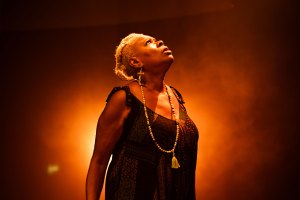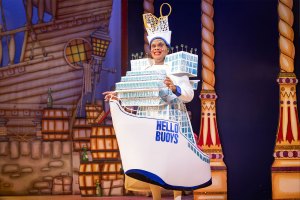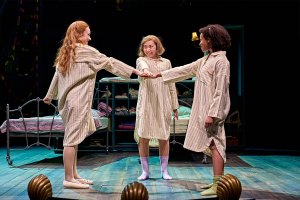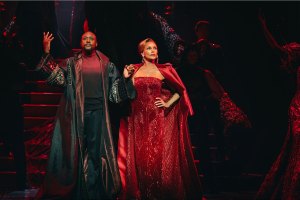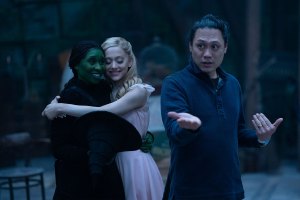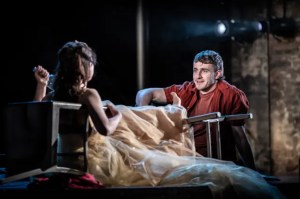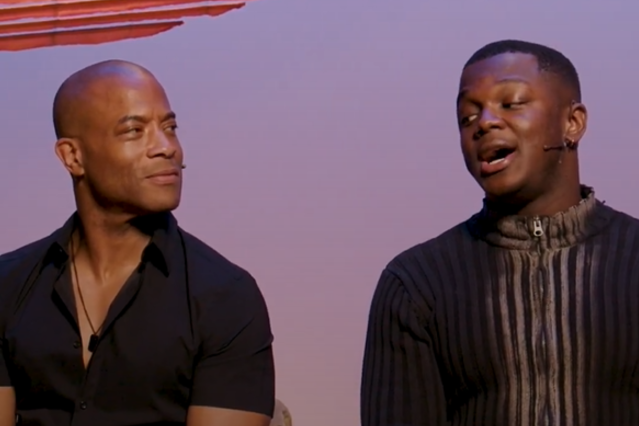”Rapunzel” at Watermill Theatre – review

© Ben Wilkin
There’s a two-page spread on ‘Fairy-tale Forests’ in the programme for Rapunzel that declares the ‘green credentials’ of writer Annie Siddons’ retelling of the Brothers Grimm’s classic story upfront.
It’s reflected (literally!) in the versatility of lighting designer Alex Musgrave’s use of gobos to suggest the fauna and flora of the forest and even the trees, thanks to green umbrellas. These are sported by the equally versatile cast of six actor/musicians under Lucy Betts’ wildly imaginative direction.
The costumes reflect the shades of green in the forest, with deliciously bright and contemporary additions like the shocking pink shirt the hero sports under his on-trend dungarees.
The design and the stagecraft are consistently and outstandingly original and inventive.You’d be sore pressed to find anything more comically clever than a trombone with a pink snout that doubles as a wild boar – respect to designer Isobel Nicolson!
Siddons transplants the much-loved Brothers’ Grimm tale to the sunlit hills and dark forests of Tuscany, where the tension is ratcheted up from the start. A father is evidently in danger, as he flees carrying a baby. He leaves her concealed in a night garden, when he runs out of milk (and his explanation that her mother is sleeping in the earth hints at a sinister back story). So, Rapunzel is a foundling – discovered and adopted by magical herbalist Mother Gothel (a determined Miiya Alexandra). She names her Rapunzel after one of her herbs and vows to pass on the secrets of her craft to the little girl.
Pleasingly to us the audience, though not to her overprotective ‘mother’, Rapunzel (a wonderfully watchable Tilly-Mae Millbrook) grows into a feisty young tomboy with green hair in an impossibly long rope-like plait. After she gets into one-too-many scrapes, Mother Gothel takes drastic action, building the magical tower, which, she assures Rapunzel, is done entirely out of love and for the girl’s own safety.
Suggesting the passage of time provides another splendid opportunity for the onstage company, the design team, and especially for composer and sound designer Tom Attwood and movement director Adrian Quinton, to collaborate on this totally theatrical and family-friendly experience. To reveal that it all works out happily ever after is hardly a spoiler alert… but it’s the journey that counts and this journey is led by the six-strong cast completed by Emma Barclay and Jess Lobo (all playing multiple roles, human, animal, and even vegetable).
There are delicious on-the-nail topical touches. The Italian setting, where it is singing heard from windows that connects lonely folk, was a lockdown story from that country which went viral. The idea of buying a smallholding in the Tuscan hills with a couple of sheep (yes, two more cameos for cast members!) and welcoming paying guests – that is the dream of a potential villain who turns and makes good – is an early version of Airbnb. The effects of inflation that increase the price of staple foods weekly from 20 lire to 2,000 and then 200,000 and the Tuscan Duchess’s (also Alexandra) bankrupting her land to borrow money to pay for the search when her son (and Rapunzel’s beau), the young Patrizio (Loris Scarpa), both hit home with the young and enthusiastic audience members to whom I spoke.
It is satisfyingly dark, as all good fairy tales should be. There are also plenty of traditional pantomime staples, including audience participation. The young members enthusiastically yell as one ‘Rapunzel, Rapunzel, let down your hair!’.
So, should Rapunzel as retold in the Watermill’s thrilling house style be on everyone’s Christmas show wishlist? The answer from me and the enthusiastic young schools’ audience who shared the fun with me is a resounding ‘Oh yes it should!’




